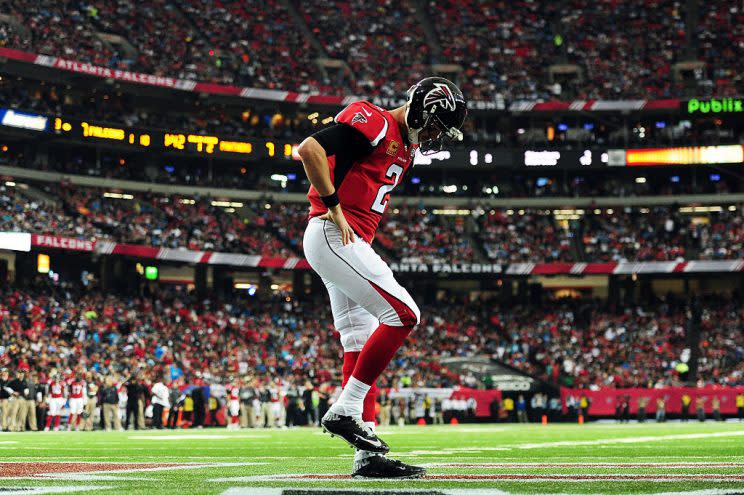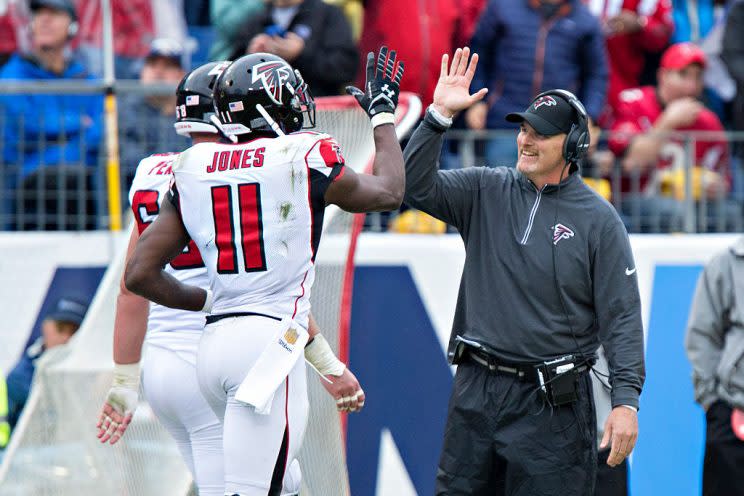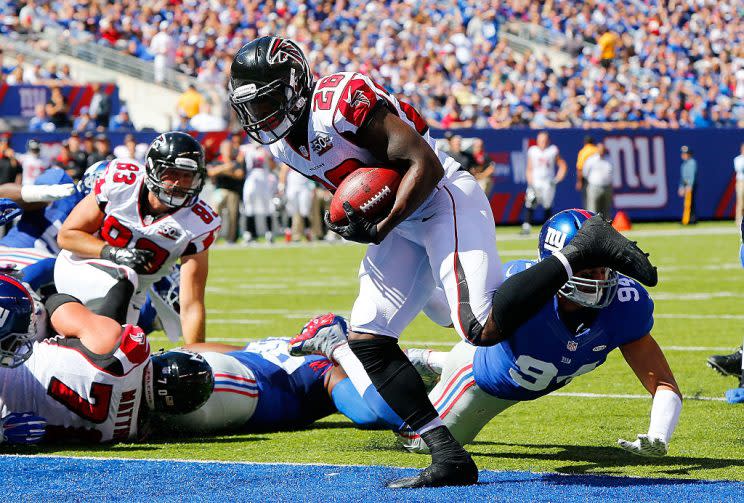Juggernaut Index, No. 20: The Atlanta Falcons

The Juggernaut Index is our annual ranking and review of NFL teams for fantasy purposes — repeat: FANTASY PURPOSES. Here, we concern ourselves with a franchise’s likely contributions to the fantasy player pool. We are not concerned with projected wins and losses. Instead, we’re focused on yards and points. As always, we’re beginning with the league’s least useful teams, working our way toward the elite fantasy juggernauts.
[Yahoo Fantasy Football is open for the 2016 season. Sign up now!]
Let’s talk about how good Matt Ryan isn’t. Ryan posted the lowest touchdown percentage of his eight-year career in 2015 (3.4), throwing for just 21 scores on 614 attempts while being picked 16 times. His passer-rating dipped to 89.0, which ranked No. 20 in the league — behind guys like Cutler and Hoyer, narrowly ahead of Bridgewater and Tannehill. He’s tossed 47 interceptions over the past three years.
At age 31, with a string a forgettable seasons behind him and only one elite weapon in his receiving corps, it seems silly to forecast a top-10 or 12 fantasy finish from Ryan. He’s been an interception machine in camp, for what it’s worth. He was picked off by his own OC last Thursday. (Not totally on Ryan, but c’mon. Not a good look.) If you want to draft Matty Ice as the less-interesting half of a fantasy platoon, I suppose that’s fine. But he’s simply not an every-week play at this stage, while surrounded by a mostly uninteresting supporting cast. He’s given us only six games with three or more TD passes over his last 48 starts; production like that doesn’t pay the fantasy bills.

Julio Jones remains as freakishly gifted as any player at his position and he led the NFL in receiving yards last year, posting the second highest single-season yardage total in league history (1871). Jones joined Calvin Johnson, Jerry Rice and Antonio Brown as the only receivers to ever reach the 1800-yard plateau. Julio also roasted Josh Norman & Co. for 266 yards over two games last December, so he’s as matchup-proof as it gets. If there’s a weakness in Jones’ fantasy game, it’s the curious fact that he’s produced underwhelming touchdown totals throughout his career, Andre Johnson-style. He’s only snagged 14 touchdown receptions over the past two years, despite catching a ridiculous 240 balls on 368 targets. This doesn’t seem like a Julio problem, necessarily — we have no reason to believe he’s TD-averse. And it’s not as if the Falcons don’t look his way in the red-zone. Last year, Jones ranked sixth at his position in total RZ targets (22) and he tied for sixth in targets inside-the-10 (11). Ryan’s ordinariness has obviously been an issue, as has the team’s general inability to pile up points. Atlanta’s offense ranked No. 21 in total scoring last year and No. 18 in RZ touchdown rate.
But even if Jones isn’t a lock to give us double-digit spikes, he’s still a dominant receiver coming off a historic campaign. In a healthy season, his floor is probably 100 catches and 1400 yards. Draft him in the first half of Round 1 with confidence. If he doesn’t see another 180-plus targets in the year ahead, it’s gross negligence.
Jones will basically never see single coverage in 2016, because he’s a player with superhero-level physical tools and the rest of this team’s receiving group is nothin’ special by NFL standards. These are not the 2012 Falcons; vintage Roddy White isn’t in the team photo. Instead, free agent acquisition Mohamed Sanu will serve as Atlanta’s unrivaled No. 2 receiver. He’s a nice enough player accustomed to a supporting role; if we assume Matt Ryan is good for another 4400 empty yards, then Sanu can easily give us a 65-800-6 stat line. And it’s fun when he’s allowed his annual pass attempt (which he always completes), so you have that to look forward to. I don’t view Sanu as a player with notable breakout potential, so he’s not a guy I’m drafting as a top-50-ish WR. It won’t be a surprise if he has a big game (or two) to which the fantasy expert community overreacts.
If you’re playing in, say, a 16-team league, then you’ll want to know that Justin Hardy is the Falcons’ No. 3 receiver. It sounds like he’s made some wow-plays in camp, too. But it would be an absolute shock if Atlanta produced three ownable, playable fantasy receivers this season, so you have to leave Hardy alone in most leagues. At tight end, this team has paired an old-and-boring vet, Jacob Tamme, with a young-and-boring rookie, Austin Hooper. You won’t be drafting either player in leagues of standard size and shape. First-year tight ends only rarely make fantasy noise — it’s a once-a-decade event — so Hooper is strictly for the dynasty crowd.
Devonta Freeman was an unstoppable fantasy terror for five weeks in the first half of 2015, and he was a thoroughly unimpressive back in every other week. Freeman produced 1634 scrimmage yards and 14 TDs last year, but 825 of the yards and nine of the scores were delivered in Weeks 3-7. His tape was something less than thrilling, even in the big games.
Honestly, Freeman is the sort of player who can make the fantasy rankings process a miserable experience. As a runner, he doesn’t really belong anywhere near the 8-12 range at his position, but we can’t just ignore last year’s numbers or his role in the offense. Tevin Coleman’s touches are going to jump in a big way if he can remain healthy, but Freeman should continue as a bankable PPR asset. He ranked third among all backs in targets (97) and receptions (73) last year.

Still, I can pretty much guarantee that when Freeman’s name is next up in my draft queue, I’ll be selecting a receiver. I can’t pull the trigger on a player near the top of a draft when I don’t trust his talent or his role. Again, this team has given us every indication that Coleman will be much more than a cameo RB this season. Here are a few recent comments from running backs coach Bobby Turner, via the Atlanta Journal Constitution:
“We want [Freeman and Coleman] competing,” Turner said. “They are very similar. They both are competitive. They both can catch the football. They both have run instincts. When it comes down to it, the one difference is the flat out long speed of Tevin Coleman.”
Doesn’t sound as if the Falcons are looking for a 350-touch workhorse, does it? Coleman did have blazing speed at his pro day workout ahead of the 2015 draft (4.39), and he was obscenely good in his final season at Indiana, rushing for 2036 yards and 15 scores. Coleman seems like a terrific buy at his current ADP (93.8), a prime target for ZeroRB drafters. Or for ManyRB drafters. He’s a well-priced player with a clear path to fantasy relevance.
Atlanta’s defense ranked middle-of-the-pack in most meaningful categories last season, although the team finished dead-last in the NFL in sacks (19). Dwight Freeney can help pressure opposing passers, but this D lacks high-end talent up front and they play a meat-grinder division schedule. No need to mess with this group in standard fantasy formats.
—
2015 Offensive Stats & Ranks
Points per game – 21.2 (21)
Pass YPG – 273.7 (6)
Rush YPG – 100.4 (19)
Yards per play – 5.6 (10)
Plays per game – 67.1 (7)
—
Previous Juggernaut Index entries: 32) Cleveland, 31) San Francisco, 30) Philadelphia, 29) Baltimore, 28) Tennessee, 27) Los Angeles, 26) Miami, 25) Detroit, 24) Chicago, 23) San Diego, 22) Minnesota, 21) Tampa Bay, 20) Atlanta

 Yahoo Sports
Yahoo Sports 

